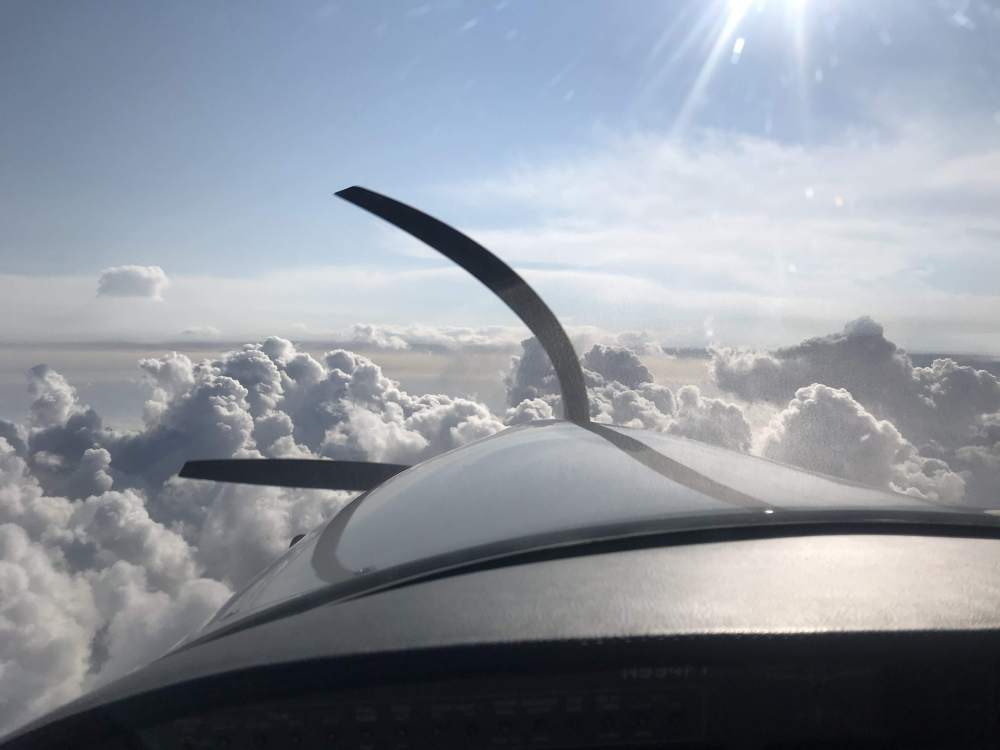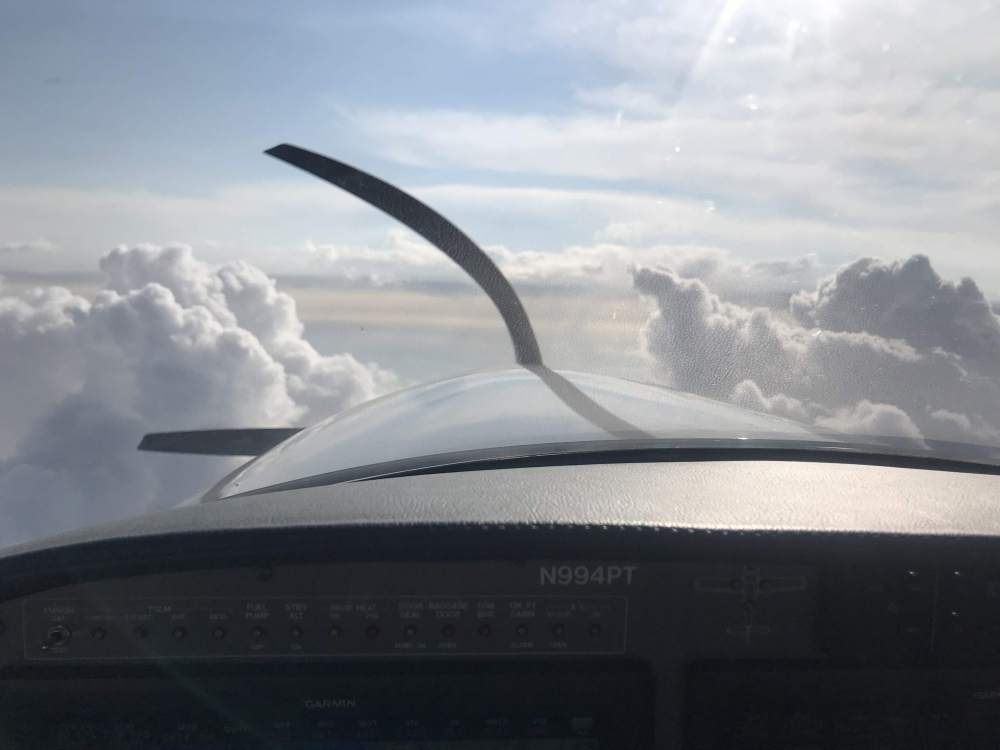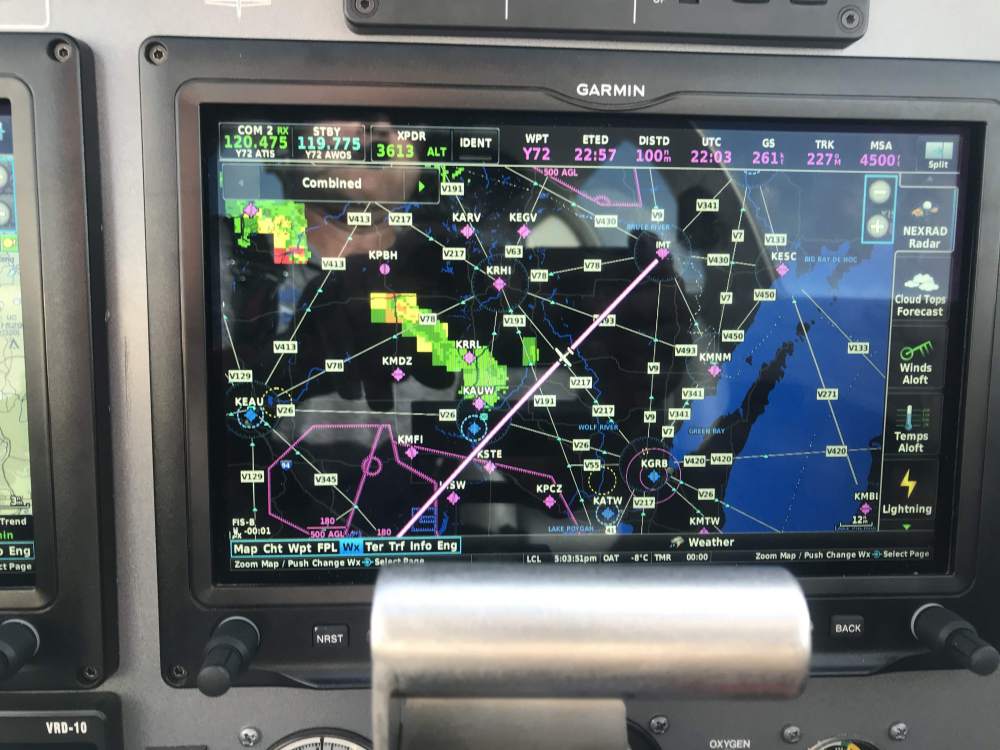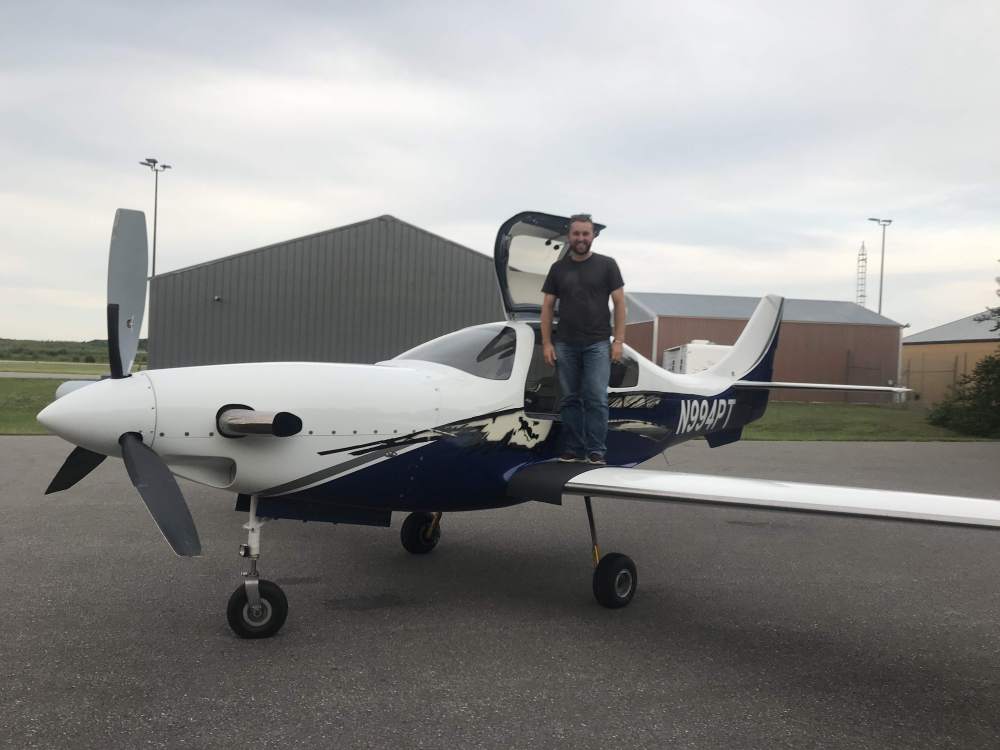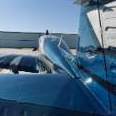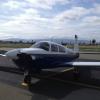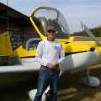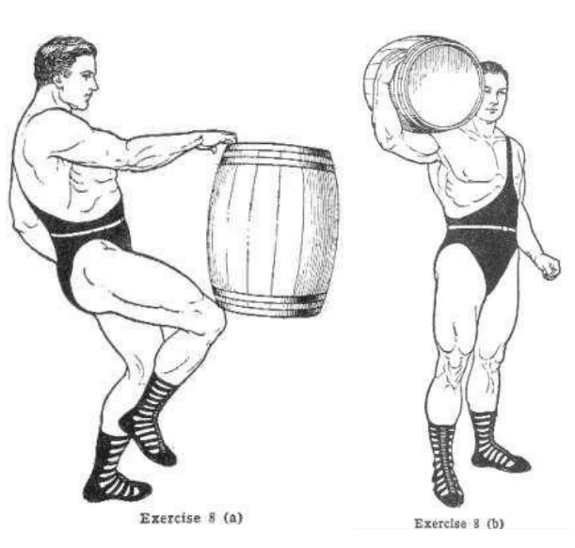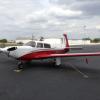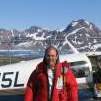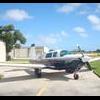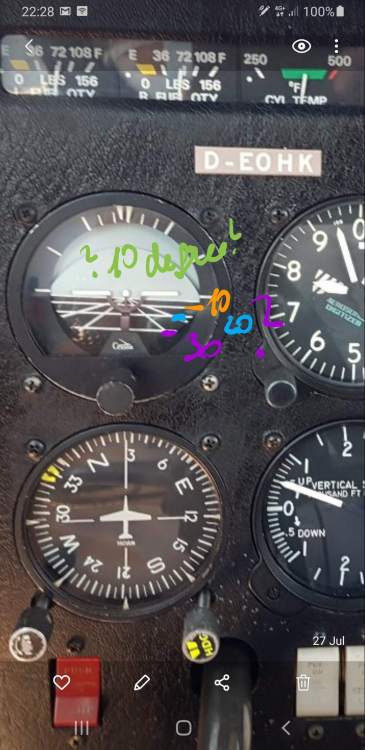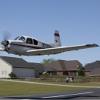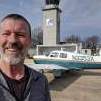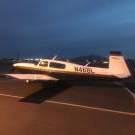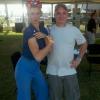Leaderboard
Popular Content
Showing content with the highest reputation on 08/26/2020 in all areas
-
I flew a friend down to Tomah WI to pick up a SUV he bought and on departure ended up waiting for a M20C departing. I headed for KRST (Mayo Clinic) to pick up a patient and when I arrived at my home airport (KIMT), saw that same Mooney sitting on the ramp. I inquired with an employee of Kubick Aviation whether they knew the owner and I was promptly introduced to Lester, @86Xray . Their customer service rep being, not only a beautiful blond bomb but, an acute sales woman, noted Tom (me) likes flying Mooney pilots in his Lancair. Maybe, if the stars aligned, I would fly down and pick him up after his annual was completed. So, today the stars aligned and I flew down and picked him up to retrieve his plane from some extensive maintenance. I enjoyed meeting and making a new friend, and I think based on his smile he enjoyed his 300+ MPH turboprop flight. Just FYI, I’m keeping a list of those that have flown with me ( @tigers2007 and@gsxrpilot ) and those that have blown off flying with me. Just kidding Erik! Nice sharing a flight with you today Lester!!! Tom10 points
-
I've got an opportunity to purchase another plane that I've had my eyes on for years. So, time to get serious about finding 11W a new home. N2711W, sn 1022. About 5,500 TTAF, 1,180 SMOH Lycoming factory, 2001. Runs strong. Basic IFR. 3-axis Brittain with alt hold that works. Basic IFR with KX-155 and KX-175, both with GS, both coupled to the Brittain. No corrosion. Tanks sealed at Wet wingologists 2001. No leaks. Hangared during my 16 years of ownership. Hangared by previous owner. Paint, interior both poor. Has some warts. Does still have an AD prop hub. Prop is about 700 TSOH and it's just started to sling a little grease. Mechanic and the prop shop said to watch it and keep it greased until a convenient time to take it off to reseal. ADS-B via Garmin 335. It's been maintained as I go. Everything works. It's just far from a beauty queen. Never failed to dispatch. I have the logs from new, scanned and the airplane records from the FAA I just got last month. If you are looking for a solid, honest, ready to go travelling machine on a budget that will take you where you need to go right now, efficiently, this might be for you. Annual due in Sept, probably open it up toward the end of the month. $30k firm, as-is. If you feel the need to haggle, $29,999 is my bottom line. Any less than that and I put an interior in it, but a used GPS com and fly it until the wings fall off. If you're seriously looking to get into a basic M20E, PM me your contact info and let's talk airplanes. If you want (and can afford) a $70,000 20E, or Bellville's former beauty, this isn't your next plane.5 points
-
The procedure to rotate a picture is simple. 1: You take your picture. 2: Then find the "@" symbol in your keyboard. 3: With the "@" symbol first, then insert "carusoam" next to the "@" symbol. For example @carusoam 4: Post your picture as normal. 5: Then you wait for a few moments or two, and then magically, your picture will be rotated. Hope this helps. Not a picture rotator. PPL only.5 points
-
On my home base the runway is 7,000’ long so I have done stop and go landings with Mooney transition students. The full stop landing is a completely normal procedure. We spend a few seconds while stopped on the runway to check and reconfigure the airplane and our brains and begin a normal takeoff with 4,000’ or more remaining. An argument against T&G is to ask “why practice something you don’t ever do as a normal or emergency operation?” Practice go-arounds from just above the runway, when the hypothetical moose wanders onto the pavement, those make sense. Low/missed approaches for IFR practice likewise are realistic. I feel T&Gs in a complex aircraft are an invitation to a higher risk of a loss of control and a runway excursion that rarely ends well for the sheet metal. So I chose not to do them.5 points
-
Older style AIs don't have pitch marks (the horizontal lines in the black ground area are not meant to be pitch references and are not equally spaced). In this case, attitude is referred to as "bar widths" above or below the horizon. According to the FAA Instrument Flying Handbook, p5-19, "The width of the wings of the symbolic aircraft and the dot in the center represent a pitch change of approximately 2 degrees." Skip4 points
-
Nice, but I expect I still be in annual starting in September The Restaurant has lots of patio dining. Those not spending the night can take a hike around and below the perimeter of the airport to pet the Buffalo and work off your lunch. Hint - don't let on what you had for lunch!4 points
-
A ride does sound like fun. However, I’m more interested in looking over the craftsmanship that Tom invested a decade and thousands of hours on. One of the highlights every year at osh is finding the home built glass aircraft that just take your breath away.3 points
-
That method works fantastically here on Mooneyspace to rotate pictures and generally fix problems here. So I figured it might work more broadly. -This year I wrote @ carusoam on my taxes hoping my taxes would get done by Anthony. That didn't work. -I am writing a boring government report right now. I try tried the @carusoam method on it but so far no good. -I need to mow the lawn. @ carusoam. No dice. Anthony is not nearly as helpful as he seems.3 points
-
There are tradeoffs in ride quality and compactness, I have been happy with the Bromptons. I can get them through the hatch, and I am pleased with how they ride. While it may not ride as well as a large wheel bike, the difference on pavement is small. I have done up to 26 miles on one, keeping a reasonable pace, and quickly forgot I was riding on tiny wheels. I prefer bikes with hub gears instead of a derailleur. Less adjustable and expensive hardware exposed to getting banged around. For us, the plane-bike combination is a great way to explore new places. An old used Dahon from the 80's will fit in the hatch, and can be found on craigslist for $100. Try it. See if you like flying then biking without the major investment. Those old bikes are real flexi-flyers, though. Know that new folders are much more rigid and comfortable. Example: https://buffalo.craigslist.org/bik/d/depew-vintage-dahon-lll-foldable-bicycle/7180878080.html (note that the images of the "folded" bike are not completely folded)3 points
-
Its my opinion that TnGo in a retract generally makes for an especially easy way to handle the gear lever wrong just once, retract at the wrong time or forget to deploy, and gear up. If I have the urge to touch and go, rather I touch, stop, reposition to the hold short, then go.3 points
-
There are a lot of questions embedded in what you asked. One major difference between the various iterations of the 231l and then stepping up to the 252 is cooling, and along with cooling (or lack of it), higher maintenance costs and less ability to get into the teens and flight levels. The original 231 engine, the GB, ran hot. That was the reason for the change to the TSIO360LB, which was somewhat better. The 231 engines have a Compressor Discharge Temperature limit of 280 dF. CDT is the temperature of the induction air as it exits the turbocharger. It is pretty easy, on a hot dayl say out west, trying to climb to the high teens or the flight levels, to see that temp. The CDT limit is there to protect the engine from detonation caused by too high induction temps, so you really don’t want to exceed it. As Paul mentioned, the original factory GB and LB also had a fixed wastegate, and because of that a critical altitude of 15,500 (more or less, it varies with the day temp and pressure). That means that after 15,500 the engine can no longer make 100% HP, and that means the climb rate rapidly becomes anemic. I don’t have the GB, I have the LB with the Merlyn and intercooler, which is a cooler running set up, but frankly I don’t see how the factory was able to get the aircraft certified to a service ceiling of 24k. On anything but a really cold day the lack of climb and CDT issues would not let you get there, at least from what I can see in my own engine. I would say the GB is fine if you stay in the mid-teens. An issue with both the GB and the LB is that they generally need a top overhaul at 1200, so expect some cost coming up on an engine that has 1,000 hours. We know more now about engine management than what was available when these aircraft came out. You can bet the prior pilot ran the engine hot and hard just because that was what was recommended, CHT max, for example, is 460. 460! Geez, your cylinders would turn into puddles before that, but that is what is in the POH and too many people ran the engine hot. You may need to do a top within a few hundred hours on an engine that has 1,000 on it now. The Merlyn wastegate is a good thing to have. Its main purpose is to prevent bootstrapping, but it also has the effect of raising the critical altitude quite a bit. I usually run into critical altitude at 22,500, as opposed to the CA of the factory engine. I can generally maintain a good climb rate up to nearly the service ceiling. The rate falls rapidly after CA, to around 300 fpm max, and the engine starts to heat up pretty quickly. Until you have experienced it, you can’t really understand how poor cooling becomes once you are at or above 18,000, the air is just to thin to help much. The intercooler helps quite a bit. CDT is the induction air temp after the turbo and before the intercooler. Induction Air Temp is the temperature after the intercooler. The intercooler, in high altitude cruise, will drop the IAT to 100 or more degrees less than the CDT. CDT, as a practical matter, no longer becomes a limiting factor. The temperature of the air entering the engine is well under 280 dF, usually under 200. So the engine generally runs cooler and you no longer need to worry about CDT as a limiting factor preventing the aircraft from climbing at a good rate. It is also better for engine longevity. High altitude operations are only part of the picture though. As a general rule, if you are going west you will be flying into the winds, and the winds aloft in the teens and flight levels will be so strong that they cancel out the benefit of a higher TAS that you get from flying up there. It is no longer worth the climb. Going east, getting up high to catch those winds is a great thing, you will see some amazing ground speeds. But a climb of, say, 19,000 feet takes quite a bit of time. I climb and descend as a general rule at 500 fpm, don’t want to hurt any passenger ears. So a climb of 19,000 will take 38 minutes, during which my ground speed will be down because of the climb. So it usually doesn’t pay to climb that high unless a flight is a couple of hours. I spend a lot of time flying in the range of 6-16,000 feet even though the plane is perfectly happy at FL210. For that purpose, a GB or LB either one is just fine. I definitely like my LB with its ability to get up to 23k or so if I really need it, but I don’t use that ability very much. I did when I first got the plane, but the novelty wore off. The 252 has two major advantages over the 231, even though it has the same basic engine, the TSIO360. The designers did a much better job of cooling the MB engine than they did the LB or GB, and that means lower maintenance costs and less likelihood of the mid-life top overhaul. The SB engine is even better. Second, they used a fully automatic wastegate. So with the GB or LB the pilot needs to manage the MP during an ascent or descent. With the MB or SB you just put in a power setting and the wastegate controller manages the MP to that setting. Another thing about the 252 engine that you can’t underestimate is that it supports a standby alternator. The alternator of the 231 is a weak point, actually, the “coupler” or clutch that connects the alternator to the engine is the weak point. It can fail, leaving you with no charging, and because of that it is imprudent in my opinion to replace the vacuum system and instruments with the more modern electrical instruments. A half hour or 1 hour backup time is not enough to get down from the flight levels, penetrate the layer you were flying over, and fly and approach to landing. My useful load is 980, and full fuel is 447 lbs. That leaves a payload of 533. It depends on how big you are, how many people that will handle. I can generally carry two men up front, a woman in back and a little luggage, or me, my girlfriend and pretty much unlimited luggage, or a man and woman in front and two kids in the back with a little luggage. One thing worth mentioning is that all of the TSIO360s, set up properly, can be operated lean of peak. Your fuel flow will be in the 10-11GPH range depending on how much power you want out of the engine. That is a lot of range with a 75 gallon capacity. You can afford to leave some out for some trips. I do a fair amount of Angel Flights and for those, have to manage all kinds of loads, the aircraft does that well. If it is a matter of budget, I would suggest the 231 with the LB engine, intercooler, and Merlyn. Check the ability to upgrade to an MB at TBO, there is a serial number cutoff for that. If you have a high enough SN, then when it becomes time to replace the engine you can get most of the way to a 252. If budget is not as much of a concern then by all means get a 252 or even better, the Encore.3 points
-
I have loved owning and flying my 231. I've flown it close to 900 hours in the last 3.5 years. Useful load in mine is somewhere around 930 lbs which is not too bad and has the Merlyn wastegate but no intercooler. I loaded my family in it right after my panel upgrade and flew them to Maine from Oklahoma. It was a little tight width wise but that might be more from me being 6'3" and 280 lbs than the Mooney being too small...lol. Maintenance costs on mine have been extremely low. The 231 is a great airplane. I'm about to trade it to move into an Eagle that has TKS. If you wanna pull the trigger this week and buy mine before I trade it, it would definitely be a nice one to have.3 points
-
One thing I think Mooney, as well as most GA smalls planes, needs is an app that allows you to input information just like you would on a WB app but that will also allow for other info such as altimeter setting, wind speed and direction, altitude, and temperature to give you various performance info such as take off or landing distance, rate of climb, etc. I know this would require a lot of inputting of info but I think it would make pilots safer by encouraging them to make these performance calculations when it’s easy to do. I know for me trying to look at the graphs and follow the lines in the flight manual can be challenging to say the least, or especially when using the charts on my iPad. They make an app like this for Cirrus. We need one for Mooneys.2 points
-
From AIN: Self-charging Diamond Batteries Set To Power Aircraft by Charles Alcock August 25, 2020, 10:06 AM NDB is developing a self-charging nano diamond battery that it says will be able to power electric aircraft. [Image: NDB Inc.] California-based startup NDB claims it is poised to offer a diamond-based alternative to current battery technology that will be more efficient and sustainable for electric aircraft. On August 25, the company announced it has completed proof-of-concept tests on its self-charging nano-diamond battery, achieving what it claims is a breakthrough 40 percent charge, compared with charge collection efficiency rates of just 15 percent with commercial diamonds. NBD also announced it signed two undisclosed launch customers—an aerospace, defense, and security manufacturer, and a Europe-based nuclear fuel cycle products company—for a beta version of the technology. Electric aircraft and vehicles are among the anticipated early adopters of the technology. The privately-owned company is now working on the first commercial prototype of its nano-diamond battery and aims to have this available by year-end. It said the proprietary self-charging process will provide a charge for the full lifetime of any device or machine, with up to 28,000 years of battery life. The power source for the nano-diamond battery is intermediate- and high-level isotopes that are shielded for safety by multiple levels of synthetic diamond. According to NDB, the energy is absorbed in the diamond through a process called inelastic scattering, which is used to generate electricity. Since the battery is self-charging, which requires only exposure to natural air, any excess charge can be stored in capacitors, super-capacitors, and secondary cells. It does not require any external power source and also incorporates a DC-to-DC converter to control the current. Additionally, NDB said, the diamond batteries do not require materials sourced in conflict zones or those that could be ecologically damaging. “A 40 percent [charge] efficiency has never previously been achieved due to [previous] material choices and our proprietary technology has achieved this breakthrough in efficiency,” NDB’s CEO and co-founder Nima Golsharifi told AIN. “What we have achieved competes with what is available from traditional fossil fuels in terms of energy density, and it is not climate- or light-dependent [like other sustainable power sources]. NDB believes it will be able to achieve a 90 percent rate of charge. This further progress could result in smaller, lighter batteries being available. The company is now engaged in research work aimed at supporting the use of nano-diamond batteries to power eVTOL aircraft. The work is supposed by the U.S. government’s defense and energy departments. Meanwhile, NDB also has been working with eVTOL developer Bartini Aero to explore the possible use of nano-diamond batteries for its planned autonomous vehicle. Previously, Bartini has intended to power the design with hydrogen. According to Golsharifi, the batteries will provide sufficient power to support cruise flight for unmanned aircraft. The company expects to build a commercial prototype of the battery within the next three years. It said that the diamond that encases the isotopes are more than 11 times stronger than the materials used for battery cases and able to withstand temperatures of up to 3,632-deg F. The proof-of-concept testing was conducted at the Lawrence Livermore National Laboratory in the U.S. and at the Cavendish Laboratory at the UK’s Cambridge University. Experiments were led by Professor Sir Michael Pepper, a pioneer of semi-conductors and winner of the Institute of Physics Isaac Newton Medal. This story comes from the new FutureFlight.aero resource developed by AIN to provide objective, independent coverage, and analysis of new aviation technology, including electric aircraft developments.2 points
-
On the Missile it's a greater offset for the mid-body with the larger engine. And it works really well. I need more rudder on an M20J 200HP takeoff than I do with a M20J 300HP takeoff. -Seth2 points
-
By this logic, jet, corporate, and airline pilots should keep their YD off to become better pilots---not. I like having the YD. It is much better than the ones that came with the BK autopilots because of the additional sources that control the servo.2 points
-
High density altitude will affect runway length in a turbo as well. One needs to accelerate to a higher GS to achieve the desired IAS. At 10K feet, 20% higher GS is required. Climb gradient is also affected for the same reason, going faster horizontally but climbing at the same rate. Even in a turbo, high density altitude is not exactly the same as sea level operation.2 points
-
Are your discs in tolerance? Out of the Service and Maintenance Catalog: With the full weight of aircraft on the gear, for the nose the gap between the top retaining plate of the disc and the retaining collar for the C and G should be between 0 and .43", E F and J between 0 and .6". For the main gear, 0", full contact. Exceed that=replace discs. Also out out of the Service Catalog is a description with procedures, pictures, diagrams, charts and other confusing stuff on how to properly weigh a Mooney. Measuring all that stuff and doing all that math might correct a tiny amount of manufacturing tolerance but is really intended to correct for the shock disc's compression. The wheels and therefore the weight will be at a slightly different location aft in relation to the datum as weight on them increases. Seats forward, pump out fuel, sump drain the remaining fuel, add back unusable fuel, 8 quarts oil, remove all your stuff, on scales, level, measure everything the catalog says, and start the calculations. Just had mine done in February. Even though the shop did everything described, I bet they still missed something. Did they move the seats forward? Remove the canvas cover from the baggage area? My antique E6B from the seat pocket? I think it is close, but not correct.2 points
-
2 points
-
This is a recurring theme so many good hits on searching this topic. From brompton is likely the traditional best small folder, but there is a fantastic so it seems new on the block that I crave - the Helix which is a Ti quick folder from Canada - it is almost vaporware but they do exist. We have a pair of Montague bikes - which are mtn bikes with full size 26'' wheels and they ride entirely like a normal mtn bike and capable of normal off road riding. Unlike many folders that are a compromise of ride-a-bility to favor for quick fold. https://www.montaguebikes.com So the frame folds quickly in a way that with wheels off the frames easily go through the door. I take the wheels off and put them in a wheel bag and that easily goes in through the passenger door - just the wheels - so overall very easy. But not quite as quick as say a brompton. Definitely rides better than a bromton. I guess it depends - do you want a bike to ride 2 or 4 miles from the airport to town. Or do you want a bike to go somewhere and do a ride? Maybe a substantial ride.2 points
-
After completing the repair, I can give some more information of how this trim switch in our 1980 M20K works: There are a lot of safety feaures, intended to giv you full control on the trim wheel ... 1. We have a kind of electrical clutch which is activated by pushing down the plunger (?) of the switch. Without pressing the plunger, the trim motor moves ( as long as you operate the trim switch in up or down direction), but it does not turn the trim wheel. You only can hear the motor running 2. The motor itself is driven or energized via a relais. And this relais cuts the power lines to the motor in case you press the trim interrupt button . 3. the trim switch itself connects both power lines of the motor to GND as long as the trim switch is in neutral. Someone really wants to have the motor disconnnected from the trim assembly! But first to the switch: This littke assemby has 3 micro switches of the same type and each as a normally-closed contact and a normally-open contact together with a thrid contact - COMMON. The middle micro-switch is operated by pressing the plunger down - that's it. And it powers the electric clutch. As long as this clutch is powered by 12V, you cannot move the trim wheel by hand! The left or right switch is pressed by moving the plunger back or forward. Only one of the switches is operated at a time - never both. By making clever use of the normally open and -close functions of the micro switches these 2 switches make an "H"-wiring. This is a typical trick to reverse a DC-motor. Simple, but working and in neutral both lines of the motor are connected to ground. I will show a picture of how the back of the trim switch assembly looks. There is more: Correctly connecting the wires to the switch still does not help as the DC-motor lines are routed through an relais. Without energizing the relais your motor is disconnected and therefore not moving. This makes it difficult to partially try the function of the trim switch. The whole assembly needs to be wired correctly to give simple 12V to a simpole DC-motor! If not - only silence.2 points
-
2 points
-
2 points
-
I have never been turned down a route through the bravo over lax regardless the day or time. Take the colleseum route at 9500 and then direct AVX.2 points
-
I did an 1889nm trip from Oregon to New York last month. Was in Penn Yan for 25 hours then went back to Oregon. Took 30.7 hours round trip. Challenge if you except, I’ll buy you lunch..... Sent from my iPhone using Tapatalk2 points
-
Well....this was a bit of a 'you get what you didn't pay for" kind of thing. IIRC, it was a "training" exercise for the Marines & Seabees...a bargain, if you will.2 points
-
I have a stock 231, have owned it for for 7 years now, and love it. It has a useful load of 965 lbs and I typically operate it between 10k and 15k feet. Minus some minor bootstrapping from time to time, I have not seen any of the issues that people commonly gripe about on this site. I only recently got GAMIs installed and will say it’s a game changer. I operate between 10.7 and 11.3 GPH LOP and regularly see true air speeds in the upper 160 knot arena, after climbing to my cruise altitude at over 800 fpm the whole way near gross. I have undertaken some projects on it and dealt with the aftermath of a not great A&P that I used for the first few years of ownership (you live and learn) but my next upgrade will be an intercooler as it does get difficult to keep CHTs under 400 degrees at times in the heat of summer here in the south without putting the cowl flaps in trail. I have contemplated upgrading to a 252 from time to time when nice ones come on the market (that I can afford), but it’s hard to give up the value that you get from a 231 (performance for purchase price and operational costs). Also that UL is great when you are loading up the family and luggage for a vacation. I have about 550 lbs to work with after filling the tanks all the way up. You can’t go wrong with anything in the K family. Make sure you get yourself a good prebuy and do your research on this site about operational settings. Then have a blast. Once you go turbo you’ll never go back.2 points
-
The date slipped a bit. Apparently, there is a bigger difference between the F and J than the Garmin engineers anticipated. They had to re-engineer the mounting brackets and then had to go back to the drawing board after the original brackets showed early signs of fatigue in ground testing. It appears to be going well now, they have had the plane in the air 7 times in a week. It is due back in my hands the first week of October.2 points
-
Alternatively, you could fly over the Bravo, descend once clear, and always be within glide distance of land.2 points
-
Triflow is not the best choice for control bearings which are ball bearings and need a more viscous lubricant as specified in the maintenance manual. From my earlier post under Let’s Talk Lubrication: OK, here’s the scoop on control bearings: My M20J IPC does not list the bearings but only the next higher assemblies which are brackets with the bearings pressed into them. I confirmed with Dan Reisland at LASAR that the aileron, elevator and rudder bearings are PN3A. (I did not confirm, but believe that the flaps use PN4A bearings). I confirmed with Ivette Prerez at RBC Bearings that they are NOT sealed. Therefore, the Mooney Maintenance Manual is correct and the bearings should be oiled with a light machine oil annually/100 hrs. Skip2 points
-
This months issue covers the J model once again. Some really nice pictures of Chuck459's N4786H, PTK's N910BU, N90LH (R model) and the original artwork of Andrew's G-OBAL. Nice interior shots as well.2 points
-
2 points
-
I sometimes fly my E into an 1800ft, sea level, island airport at near gross...call it 100 under. Density alt around there may reach 2500....Shown as 2000 as we speak. I’ve never used more than half the runway. There is a small bunker at the end that must be cleared or one must sidestep. That can get a little close on a hot day, but I have plenty of water beyond. I don’t lean in this situation. You may get marginally more power in the situation you describe. I feel like the bigger issue for you was a tailwind with relatively high DA. That 6 kit tailwind will eat up a lot of runway on a hot day. Technique becomes absolutely critical. You will likely find that rotation to liftoff is a rather extended period of time. It is then easy to overrotate and the induced drag will make matters worse, so it is critical to pitch and hold ground effect for a few moments longer than comfortable until getting near Vx.....from there performance really improves rapidly. Oh, and....this is where a takeoff with some flaps makes a difference. Hard to say without knowing the airstrip, but I suspect the tailwind was worse than the slope in this case. As you said yourself, good to practice this at a longer airstrip with artificial goals. I would not do the 1800 ft runway if surrounded by trees, without headwind and if it was sloped severely. In fact, there are 2000 and 3000 ft strips that scare me more than this particular 1800 foot runway. Might also compare some other performance numbers to see if you are making power. What kind of cruise speeds are you getting and under what conditions and power settings? A flat cam might run smooth but not put out power. Good luck, stay safe and enjoy the plane. Edit: I should emphasize, the airport I mentioned also has an alternate 2300 ft runway, so there are options when the wind does not cooperate with the 1800 footer.2 points
-
2 points
-
I would say no based on a few factors. The main reason is that the nose gear has very limited play and you wouldn't be able to see the turn limit indicator on the nose gear. It's also a pretty heavy aircraft so I don't think you would want to put those kinds of forces on the tail when turning given how far aft of CG it is. If you turned it too tight you would either be damaging the nose truss or in some worse case scenario (if a tire got snagged on something), trying to bend the tail in a direction it doesn't want to go. I'm not an expert but those are my 2 cents. I currently use a Thundervolt tow bar that I purchased used: https://www.powertow.com/ThunderVolt-12-Volt-DC-Aircraft-Tug-_p_17.html. It works very well but you just need to also be careful you don't turn the nose wheel too far in one direction.2 points
-
Kpaul is correct...the E model is currently in Garmin's possession. They have begun the process for certification. This I know for sure, reguardless of what anybody says. I own the E that they have.2 points
-
I grew up on a series of Marine Corps Air Stations. Everything they fly does touch and goes. I've since had the pleasure of dodging USAF / ANG C-130s doing TnG both here in Alabama and WV . . . . Civilian jets? I dunno.1 point
-
1 point
-
Eric...I have two Montagues, and love the bike, but not getting them in and out do the plane. I have always left the rear wheel on....so it ends up in a bike bag on the seat. I feel like one of these days I’m going to take a window out or put a dent in the wing. So, regarding removal of the rear wheel, that the. Involves the chain and derailer, which seems to get messy when on the road. Maybe I’m just messy, but even without wheel removal if seem to get covered in chain oil. Any advice in this area? I too keep looking for the holy grail in Mooney bike...1 point
-
1 point
-
1 point
-
One thing to keep in mind regarding measuring.... The nose wheel distance has the ability to change with Donut Compression... So... the plumb bob from the reference bolt... to the center of the wheel... needs a good measurement... If it gets out of a certain range... the wild rides begin... something about wheel caster... Mooney Mysteries are the best! Best regards, -a-1 point
-
its the old style J spinner for a Hartzell pretty much only used on conversions , as every J that I have seen has a Macauley prop... Plane will fly fine with that crack in it , it will be a bitch to fab... The Macauley prop blades are farther from the hub flange than Hartzell , so they are not interchangeable..1 point
-
1 point
-
“26 miles across the sea, Santa Catalina is awaitin’ for me, Santa Catalina, the island of romance”...... I personally don’t think petting Buffalo is very romantic!, but it’ll be fun to fly over and land on the new runway! 10 minutes of pucker time over the ocean blue...... yikes!1 point
-
I have a Missile 1983/2001 with speed brakes and am also interested in this discussion. As any Missile owner knows we are constantly flirting with the forward edge of the envelope. I have been trying to determine how adding these tanks affects the CG arm during the fuel burn. only data I can find so far is the 10-12 lbs @ 71 inches for the install weight and 15 gal per wing if speed brakes installed. If anyone can reveal the fuel arm for the Monroy aux tank it would be great. I have had the Missile for almost 20 years without the tanks, but am seriously considering the mod now as my flight mission is changing to visit kids far away.1 point
-
1 point
-
This gets into an area of technique. One of my gripes with CFIs is that a lot of them have a favorite way of doing things and try to remake every pilot in that image. I only have two requirements for pilot technique when I work with an experienced pilot: 1) it has to be safe, and 2) the pilot should have a reason for using that technique. (The most common reason is that's what my first CFI taught me. That's OK, but as we gain experience, it is good to revisit why we do things from time to time). So, here's what I do in my M20J which seems to work in all circumstances with minimum fuss: I hold about 5 lbs back pressure during the takeoff run and let the airplane fly off releasing the pressure to attain a 10 degree initial pitch attitude. (Piston airplanes don't really have to be rotated -- that's a jet thing). As soon as I have a positive rate of climb, I retract the gear. (I see no reason to delay retracting the gear. On a short filed with obstructions, I'd want it up as soon as possible. I like to use the same procedures consistently and so I use the same technique on all takeoffs. The possibility of an engine failure during the few seconds when a landing on the remaining runway would be successful seems so remote as to not require serious consideration). Once clear of obstacles, I lower the nose to 7.5 deg (because there is a hash mark for that on the AI) retract the flaps and allow the airplane to accelerate through best rate to cruise climb. Skip1 point




